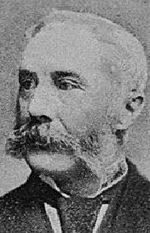Andrew Cathcart Bogle facts for kids
Quick facts for kids
Andrew Cathcart Bogle
|
|
|---|---|

Major Bogle
|
|
| Born | 20 January 1829 Glasgow, Scotland |
| Died | 11 December 1890 (aged 61) Sherborne, Dorset |
| Buried | |
| Allegiance | |
| Service/ |
|
| Rank | Major |
| Unit | 72nd Highlanders 78th Highlanders 13th Regiment of Foot 10th Regiment of Foot 23rd Regiment of Foot |
| Battles/wars | Anglo-Persian War Indian Mutiny |
| Awards | Victoria Cross |
Andrew Cathcart Bogle was a brave Scottish soldier. He was born on January 20, 1829, and passed away on December 11, 1890. He is famous for receiving the Victoria Cross (VC). This is the highest award for bravery in the face of the enemy. It is given to soldiers from the United Kingdom and Commonwealth countries.
Contents
Andrew Bogle's Early Life and Army Career
Andrew Bogle was born in Glasgow, Scotland. He went to school at Cheltenham College. In December 1849, he joined the 78th Highlanders regiment as an Ensign. An Ensign was a junior officer who carried the regiment's flag. He became a Lieutenant in March 1853.
He fought with his regiment in the Anglo-Persian War in 1857. This was a conflict between Britain and Persia. After this war, his regiment went to India. A big rebellion, called the Indian Mutiny, had just started there.
Joining the Fight in India
The 78th Highlanders joined a group of soldiers led by General Havelock. Their mission was to help the soldiers stuck in the siege of Lucknow. A siege is when an army surrounds a place to try and take it over. It was during this advance that Andrew Bogle showed incredible bravery. This act earned him the Victoria Cross.
A Moment of Great Bravery
Andrew Bogle was 28 years old when he earned his Victoria Cross. He was a Lieutenant in the 78th (Highlanders) Regiment of Foot. This brave act happened on July 29, 1857. It was during an attack on a place called Oonao in India.
Here is what happened:
Lieutenant Andrew Cathcart Bogle showed amazing courage. On July 29, 1857, during the attack at Oonao, he led the way into a house. This house was strongly held by the enemy. It had small holes (loop-holes) for firing guns. The enemy was shooting heavily from it, making it hard for his regiment to move forward. Captain Bogle was badly hurt while doing this important service.
For his bravery, Queen Victoria herself gave him his Victoria Cross. This special ceremony took place on January 4, 1860, at Windsor Castle.
Andrew Bogle's Later Military Life
In February 1858, Andrew Bogle became the Adjutant of the 78th Highlanders. An Adjutant is an officer who helps with the daily running of the regiment. He continued to serve with his regiment during the rest of the Indian Mutiny. He was part of the final capture of Lucknow. He also fought in the action at Bareilly.
In August 1858, he was promoted to Captain. He then moved to the 13th Foot regiment. Later, in August 1859, he moved to the 10th Foot. In April 1865, he became a Major. He transferred to the 23rd Foot in August 1868. Soon after, he retired from the army.
After leaving the army, Andrew Bogle lived in Sherborne House, Dorset. He passed away there on December 11, 1890, at the age of 61. He had been ill for a long time. His ashes were buried in St Lawrence's Churchyard in Effingham, Surrey.
Where to See His Victoria Cross
Today, you can see Andrew Cathcart Bogle's Victoria Cross. It is on display at The Highlanders Museum. This museum is located at Fort George, in Inverness-shire, Scotland.

